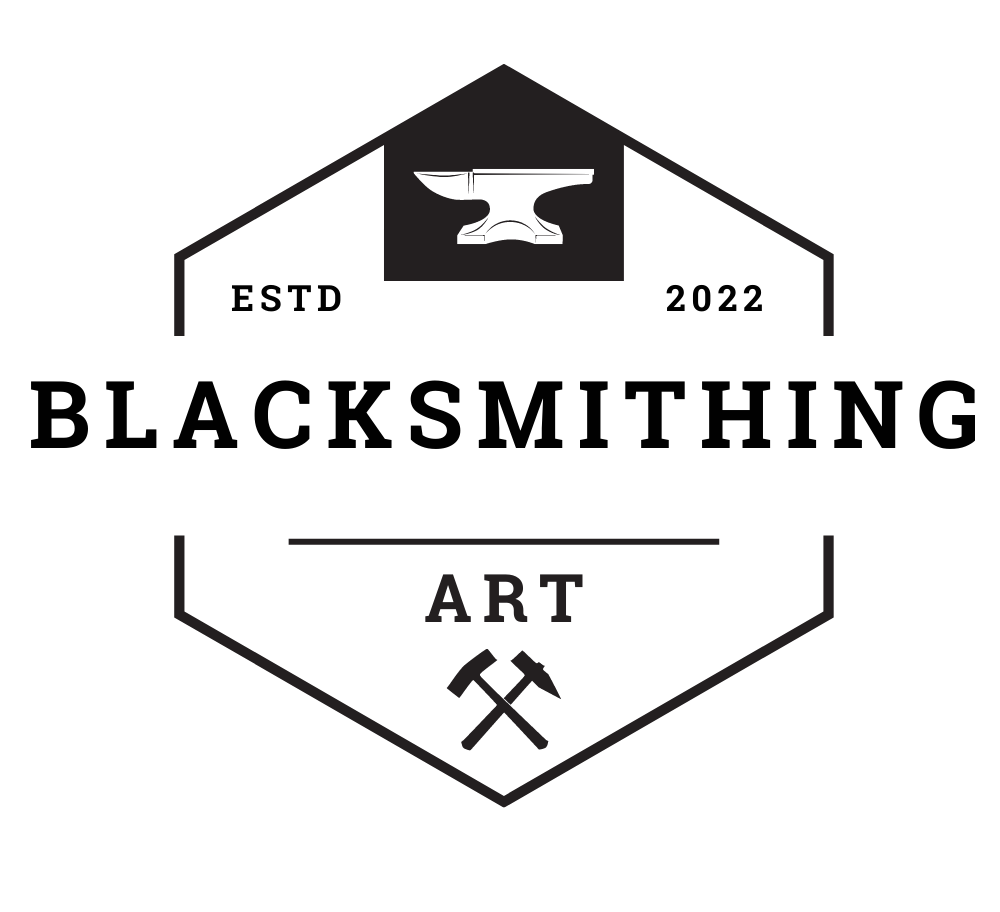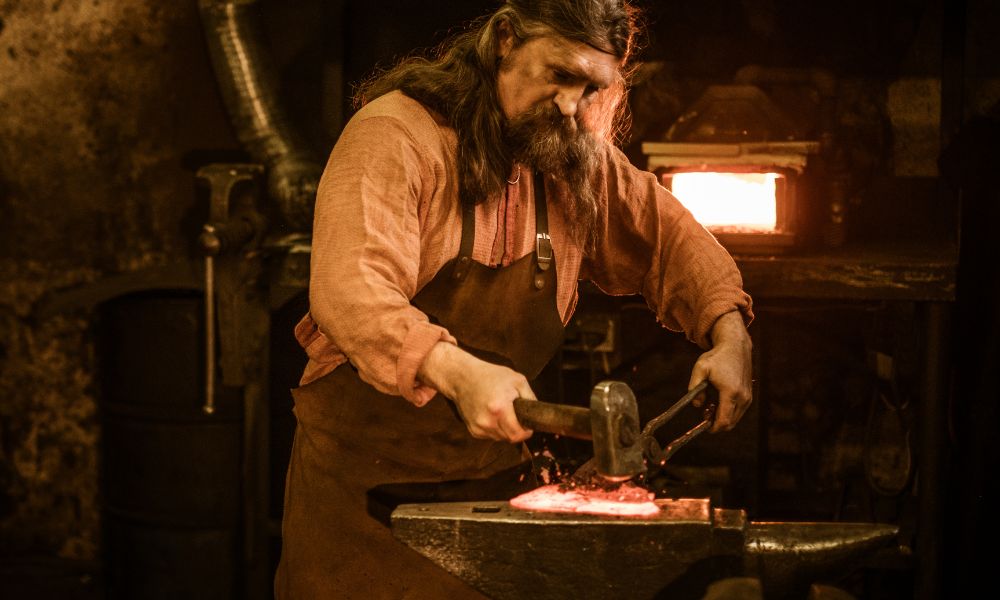In this article, we will dive into the world of medieval blacksmiths and their clothing. We will learn about the importance of aprons and leather boots, as well as the fabrics and bright colors that were used to fashion their clothes in the Middle Ages.
We will also look at the gloves that were used to protect the medieval blacksmith from the heat of the metal. Join us as we explore the clothing of blacksmiths and learn about their trade.
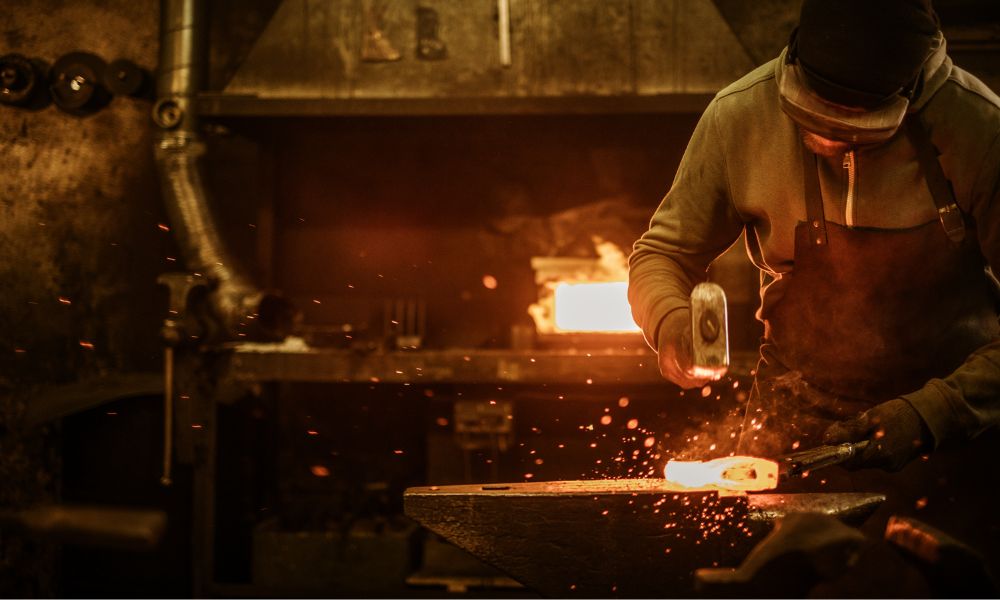
Contents
About medieval blacksmiths
Skilled tradesmen who played a vital role in society during the Middle Ages. They worked with metal to craft a variety of items, including weapons, tools, horseshoes, and household items.
Blacksmiths were respected for their ability to turn raw materials into useful items, and their work was essential to the daily lives of people in medieval times.
They often worked in a smithy, which was a workshop that contained a forge for heating metal, anvils for shaping and hammering metal, and various things for cutting, bending, and finishing metal. The work of a blacksmith was physically demanding and required a high level of skill and precision.
Clothes of a medieval blacksmith
In the Middle Ages, blacksmiths were a vital part of society. They were skilled tradesmen who crafted everything from weapons to horseshoes, and their work was essential to the daily lives of people.
In order to supplement the information, read also the article – What Kind of Clothing Did a Blacksmith Wear in the Colonial Days?
How these clothes were worn
In addition to being durable and protective, the clothing worn by medieval blacksmiths had to be practical and comfortable. The work of blacksmithing was physically demanding and required a full range of motion. Therefore, the clothing was designed to allow for movement while offering protection.
Shirts and Trousers
A medieval blacksmith typically wore shirts made from wool or linen. These shirts were long-sleeved and often reached below the knee. They were loose-fitting to allow for movement, and some shirts had ties at the neck to adjust for comfort.
The trousers worn by blacksmiths were also made from wool or linen and were typically loose-fitting. They were often tied at the waist with a cord or belt.
Aprons
The leather apron worn by blacksmiths was typically tied at the waist with leather straps. The apron covered the front of the blacksmith’s body and often reached below the knee.
The apron also had a bib that covered the chest area. This bib provided additional protection from sparks that flew off the heat of the metal.
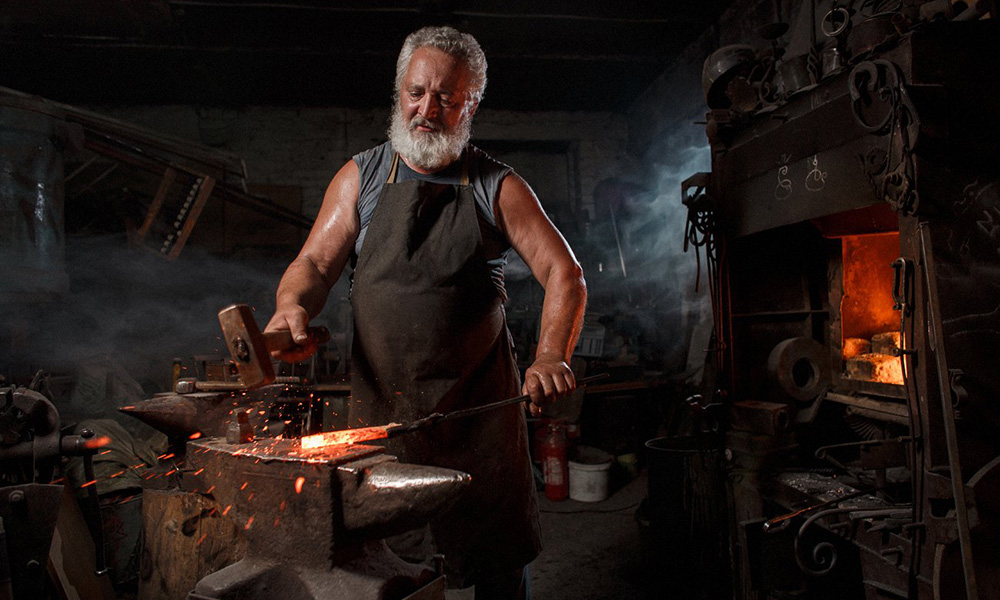
Boots
A medieval blacksmith wore leather boots that reached above the ankle. The boots were designed to be durable and protect the feet from falling objects and hot slag. They were typically tied with leather laces to ensure a secure fit.
Neck and Beard
The clothing in the Middle Ages worn by blacksmiths did not typically cover the neck. This was because a high collar could be uncomfortable and restrict movement. However, the bib on the leather apron provided some protection for the chest and neck area.
As for the beard, it was not uncommon for blacksmiths to have a beard, but they typically tied it back to prevent it from getting caught in torrid metal or tools.
The clothing worn by blacksmiths was designed to be durable, protective, and practical. Shirts and trousers were loose-fitting to allow for movement, while aprons, boots, and even beards were protected from the heat of the metal.
Fabrics and bright colors
While leather in the Middle Ages was the primary material used for blacksmith clothes, other fabrics were also used. Wool clothes and linen were commonly used for shirts and trousers.
Cotton was not widely available in Europe until the 14th century and was initially considered a luxury item, so it is unlikely that it would have been used for everyday clothing for a medieval blacksmith.
However, in later periods, cotton became more widely available and affordable, and cotton may have been used for some lighter garments worn by blacksmiths.
Brighter colors were also used to style their clothes, such as reds, blues, and greens.
The use of brighter colors not only added some fashion to the blacksmith’s attire but also made them more visible in the crowded and dimly lit smithy.
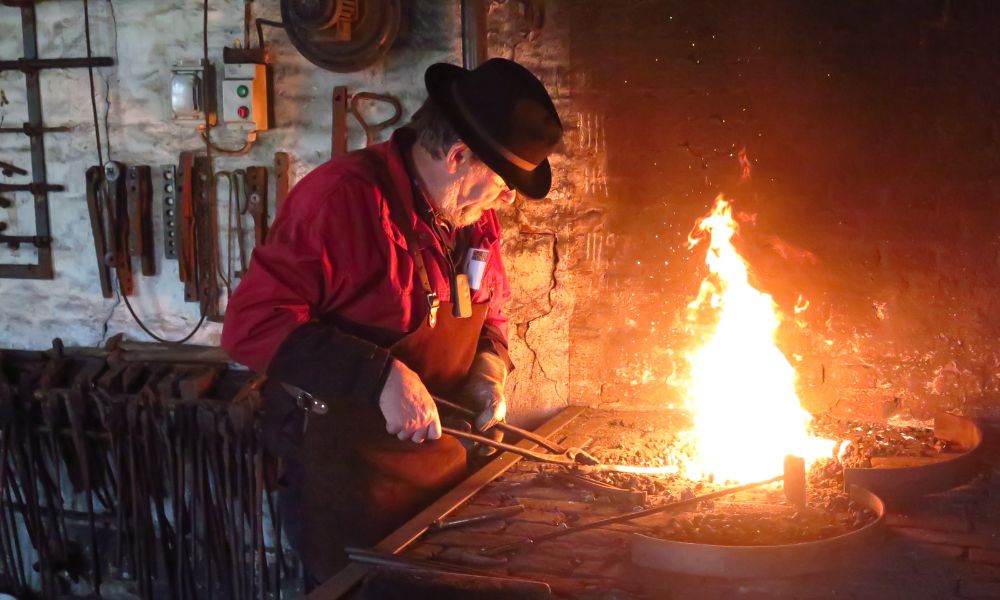
The symbolism of blacksmith clothing in medieval times
In addition to practical purposes, clothing worn by blacksmiths in the Middle Ages also had symbolic significance.
The leather apron, for example, represented the blacksmith’s trade and was a symbol of their profession. It was often passed down from generation to generation, and a blacksmith’s apron was considered a valuable possession. In some cases, an apron was even buried with its owner as a symbol of their craft.
Similarly, the bright colors used in blacksmith clothes also held symbolic meaning.
Red symbolized strength and power, while blue represented loyalty and trustworthiness.
Gold in medieval times was frequently associated with wealth, power, and royalty. It was a highly prized and valuable metal, and clothing or accessories adorned with gold were often worn by the wealthy and elite.
Green symbolized growth and new beginnings, and yellow was associated with happiness and joy. By wearing these colors, blacksmiths were not only protecting themselves but also expressing their personalities and beliefs.
Blue was typically associated with the Virgin Mary, making it a highly symbolic color in religious art and clothing. It was also a symbol of purity, loyalty, and trustworthiness.
Purple was a highly symbolic color in medieval times, often associated with royalty and nobility. It was a difficult color to produce and was therefore expensive, making it a symbol of wealth and power.
Tools and gloves
In addition to protective clothing, blacksmiths in the Middle Ages also used specific tools and gloves to protect themselves from the heat of the hot metal. Thick gloves were used to protect their hands from burns and cuts, while long tongs and pliers were used to handle the hot metal.
The instruments were also fashioned from durable materials such as metal and leather to withstand the heat and wear and tear of blacksmithing.
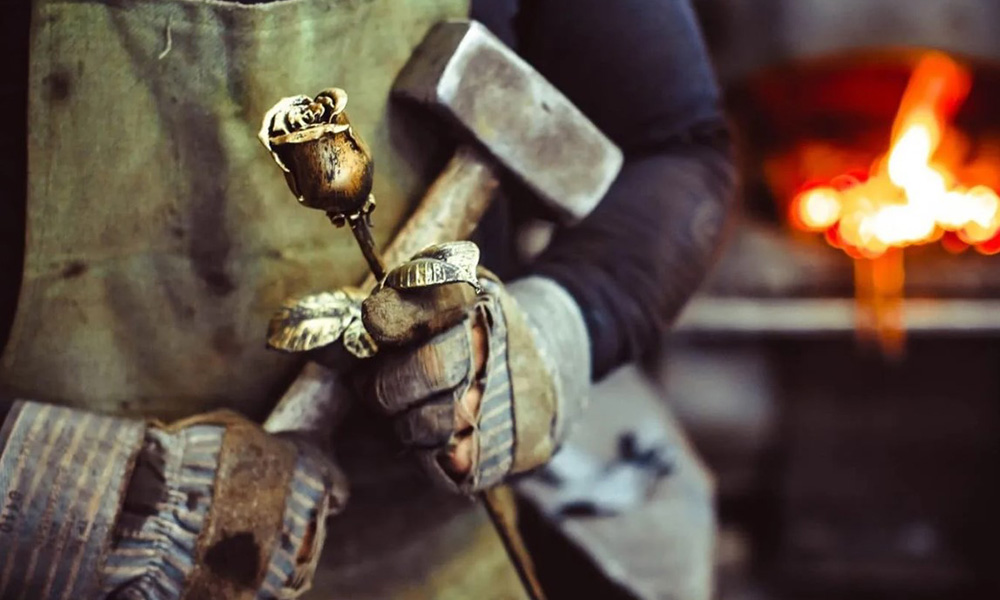
The dangers of hot metal
Torrid metal was the bread and butter of the blacksmith’s trade, but it posed a significant danger. Molten metal can reach temperatures upwards of 1,832 degrees Fahrenheit, which can cause serious burns and injuries if not handled properly.
In the Middle Ages, the blacksmith’s forge was the heart of the smithy, and it was where the metal was heated to the right temperature for shaping and forging. The intense heat and bright flames of the forge could also be blinding, making it difficult to see the metal and the instruments being used.
To work with metal safely, blacksmiths had to be skilled and experienced.
They knew the properties of the metal they were working with, such as its melting point and malleability, and they used this knowledge to shape it into the desired form. They also had to be aware of the dangers of the torrid metal and take precautions to protect themselves.
Protective clothing
One of the most important precautions that medieval blacksmiths took was to wear protective clothing. As mentioned earlier, aprons and boots were essential in protecting the blacksmith’s skin from burns and injury caused by hot slag and sparks.
But it went beyond just leather garments. Blacksmiths also wore protective gloves, made from thick and durable materials such as leather, to protect their hands from burns and cuts. They also wore protective eyewear to shield their eyes from the bright flames and hot sparks of the forge.
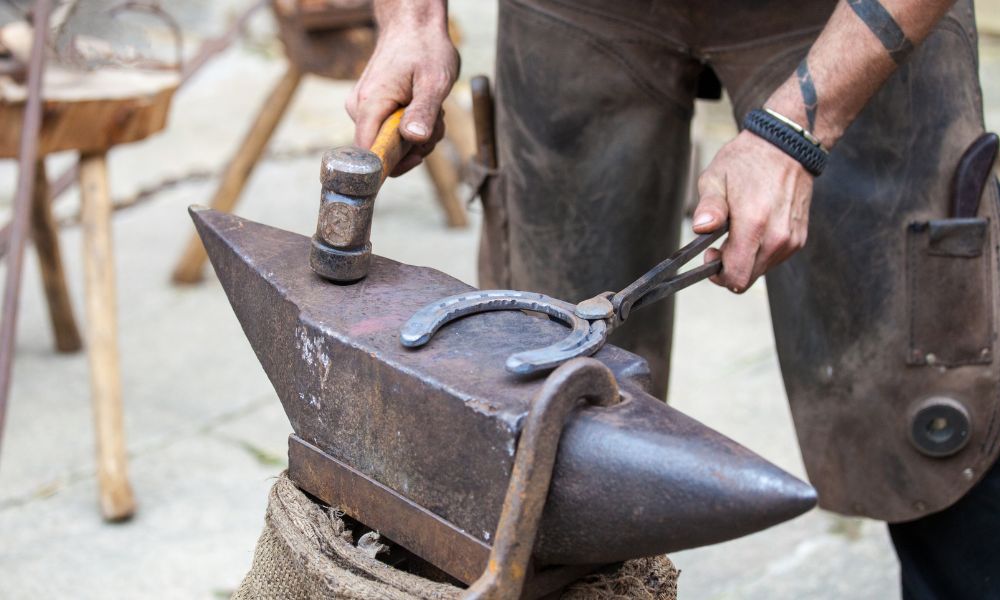
Tools and Techniques
They also used hammers and chisels made from tough metals to shape and forge the metal into the desired shape. The blacksmith’s anvil was also a crucial tool, as it provided a sturdy surface to work on and a place to shape the metal using the hammer and chisel.
In the Middle Ages, metal was the lifeblood of the blacksmith’s trade, but it was also a significant danger. Medieval blacksmiths knew the properties of the heat and metal they were working with and took precautions to defend themselves.
They wore protective clothing such as aprons and boots, thick gloves, and eyewear to shield themselves from the dangers of the forge. They also used specific instruments and techniques to work with the hot metal safely.
Today, modern people of blacksmithing still use many of these same techniques and protective gear to work without professional risk of damage.
Modern blacksmiths
Today, blacksmithing is still a trade that is practiced around the world. However, the clothing worn by modern blacksmiths has evolved.
While aprons and boots are still worn, modern masters also wear protective clothing made from fire-resistant fabrics such as cotton and Nomex. Gloves and other protective gear have also been modernized to provide better protection for the blacksmith.
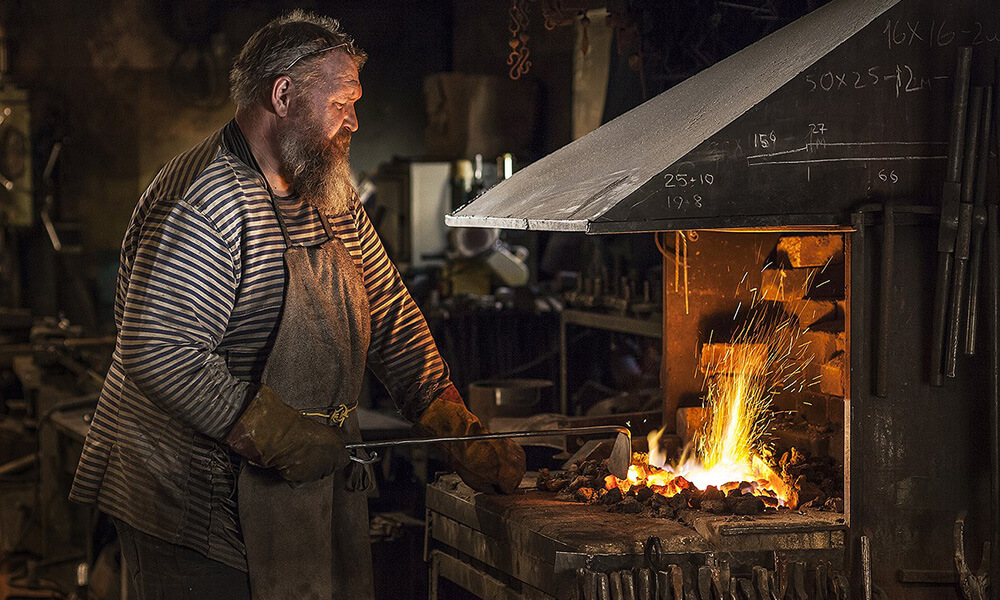
Perhaps you will be interested in an article about women in blacksmithing, where historical facts are given.
FAQ
What did medieval blacksmiths wear?
Medieval blacksmiths typically wore durable and protective clothing, such as leather aprons and boots, wool or linen shirts and trousers, and thick gloves to protect their hands from the heat of the forge. Bright colors were also used to make them more visible in the crowded and dimly lit smithy.
What clothes did blacksmiths wear?
Blacksmiths wore clothing made from durable and heat-resistant materials, such as leather, wool, and linen. The clothing was designed to defend them from the heat and sparks of the forge, as well as falling objects and cuts.
What was in a medieval blacksmith shop?
A medieval blacksmith shop, or forge, typically included a forge, anvil, hammer, tongs, pliers, and other tools needed for blacksmithing. The forge was the centerpiece of the shop and was used to heat the metal to a malleable state so that it could be hammered and shaped into various objects.
How do you dress like a blacksmith?
To dress like a blacksmith, you will need clothing made from durable and heat-resistant materials, such as leather aprons and boots, wool or linen shirts and trousers, and thick gloves.
You may also want to consider wearing protective gear, such as safety glasses, earplugs, and a respirator, as blacksmithing can be a noisy and dusty process. It is important to dress comfortably and in layers, as the heat of the forge can be intense.
Conclusion:
The clothing worn by medieval blacksmiths served both practical and symbolic purposes. The leather apron represented the blacksmith’s trade and was a symbol of their profession.
It was designed to be durable and protective, allowing for movement while offering protection. Shirts and trousers were loose-fitting, while aprons and boots protected from the heat.
The bright colors used in blacksmith clothing held symbolic meaning, expressing the personality and beliefs of the blacksmiths. The tools and gloves used by blacksmiths were fashioned from durable materials to withstand the heat and wear and tear of blacksmithing.
Overall, the clothing and tools used by medieval blacksmiths were essential to their trade, and their clothes’ durability and practicality contributed to the blacksmiths’ success.
